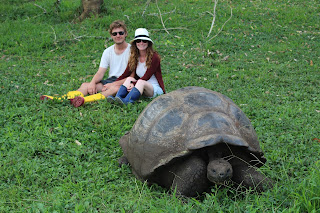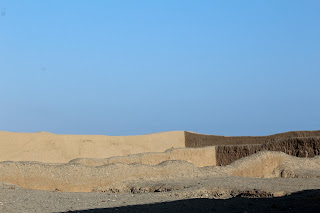The Galapagos Islands Ecuador

A trip to the Galápagos Islands was part of the original honeymoon plan, but as you all know we got a little side tracked...When we finally made it our trip to the Galapagos started with a lot of haggling for cruises (more on this further on), and even more good luck. And then it wasn't long til we were on board our boat the Fragata, with 14 others, with an awesome sunset and a magical holiday ahead of us.

Our 8 days on the Fragata included a few hours of snorkelling and a couple hours of walking each day. The Galápagos is closely managed and more organised than any other tourist destination we have visited - ever. Only a few dozen or so boats are allowed into certain areas of the reserve, and then each boat is allocated specific visiting times at specific places. So we found ourselves snorkelling, walking and panga-riding in solitude.

(The Fragata and our panga)
(Sam in the panga)
The animals on Galápagos evolved without predators - not many animals could make it out here from the mainland, and while there is isn't great land-based biodiversity, the animals that we see are uniquely different to those onshore, and are abundant. Without many predators, they are naturally friendly to other animals, including humans. Also, they live in a huge reserve, so have not learned to fear humans during their own lifetimes. This means lots of opportunity to see unique animals up close.


(Hanging out with sea lions on the beach never stops being fun, and these little guys come up and swim with you, too)

(Beautiful starfish all over the ocean floor and, more rarely, on the beach at low tide)

(Mum and bub waddle past the people for a little sunset feed and dip)

(The Galapagos painted locusts can be seen all over Isabel)

(Adult and teen flamingoes feed and breed in the small lakes on Isabel and Rabida)


(Brown noddies land on pelicans' heads, trying to steal their catch)
In the water, the snorkelling is awesome. First go saw us swimming within arms reach of fearless and curious sealions, penguins, marine iguanas, flightless cormorants, turtles, tropical fish schools, rays, iguanas, boobies, and frigate birds (both in and out of the water, sitting nearby on the cliff-shore). The water had between 5 and 15m visibility, and the regular appearances of turtles, sealions and iguanas continued, with occasional sharks and rays to complete the picture. The sea lions swim right along side you and up to you, curious to meet. We don't have an underwater camera, so won't put up any aqua photos this time...

(Sam takes a dip with the pelicans at feeding time)
Lava beaches are uncomfortable, patterned and hot, as they have not yet eroded to form the multicoloured sand beaches that they will one day become.

(Lava beaches and rocks everywhere)
These volcanoes have created beautiful and extreme landscapes all over the Galapagos.



Flightless cormorants have the sleek glossy black feathers of their elegant mainland cousins, but here they have evolved to swim like penguins and given up flying. They proudly hold out their stubby wings to dry them in the same way as other cormorants though.
Penguins normally live only in cold water, but here live around tropical volcanoes, with baking hot black rocks. They live in caves, and stick to colder currents, and generally are slimmer and trimmer than other penguins.

Iguanas are big lizards that live on land, eat insects and animals and plants, and don't get on well with others so live more or less alone. Except here, where the early iguanas arrived to find only brand new islands still bare, black and smoking from the volcanic eruptions that formed them. They still live on the newest barest islands, swimming all day eating algae off rocks like sea turtles, and then snoozing together in big friendly lizard heaps on the hot black rocks.
Their cousins are still land-bound, having arrived on the islands later when soil, plants and insects had all arrived to sustain them. They are bigger, meaner and live alone in burrows.

Giant tortoises are synonymous with Galapagos, and while they are not really predators, they certainly dominate the landscape inland, bulldozing paths through the jungle. We got a chance to get up close both with some 250kg giants.

We also got to see what they look like in the 120 days they spend in the shell, before hatching.
For the first time ever, we saw jumping manta rays while commuting between islands. Not sure what makes them jump, but you can see them from quite a long distance looking like flashing kites doing somersaults. We spotted them on the same afternoon as three types of whale (pilot, humpback, brydes) that were getting friendly with the boat. In the coming days we would be surrounded by dolphins.
We were always surrounded by blue-footed boobies, but a couple of times there were so many boobies on show in and out of the water that we didn't know which way to look.


Getting to the Galapagos...
We read that it is possible to get last minute deals on cruise ships, so decided to just turn up and try. We started asking around in Guayaquil, then quickly realised that in high season the only last minute deals are from cancellations. There are less deals than people wanting them so the discounts are more like 20% not 50%, and when the cheapest nastiest "tourist class"cruises cost US$2000 per person plus flights and entrance fees (another US$600 each), it is a pretty expensive exercise even with a last minute special.
So, we went back to the drawing board and set out to do the Galápagos Islands independently; staying in the inhabited islands and getting day trips out to the national park-only islands, instead of sleeping on a ship. This is totally feasible, and there is plenty of info online about it and what to see. What it doesn't tell you though is that the best islands (and even the best parts of the inhabited islands) with the most life are reserved only for cruise ships, and you can't get a day trip there from the main islands for love or money.
We realised this after haggling with a few day-trip boat operators for a few hours, and decided to damn the expense we'll go on a cruise and see the best of Galapagos. And so the Sam and May machine fired up, and while May kept some tour operators tied up chasing some backup plans (and preventing other people from getting the berths we wanted) Sam gave a call to the most reasonable cruise ship operator we had contacted onshore during preparations. It came down to the wire, but we snapped up the last two berths on a first-class family-operated ship (at a "honeymoon gift" discount) that was already a few hours into its 8-day tour, and got a lift to the other side of the island with the final supplies of linen, butter and food... and Sam n May. We got on at sunset literally as the boat was pulling up its anchor to sail way out to the far reaches of the archipelago. When we boarded, we found we were in a top floor cabin across the hall from the captain, marked on the deck plan as the "owners cabin", with a double bed, private bathroom and big window - it was nicer than some hotels we had stayed in. This was a very good beginning, and only got better.





















